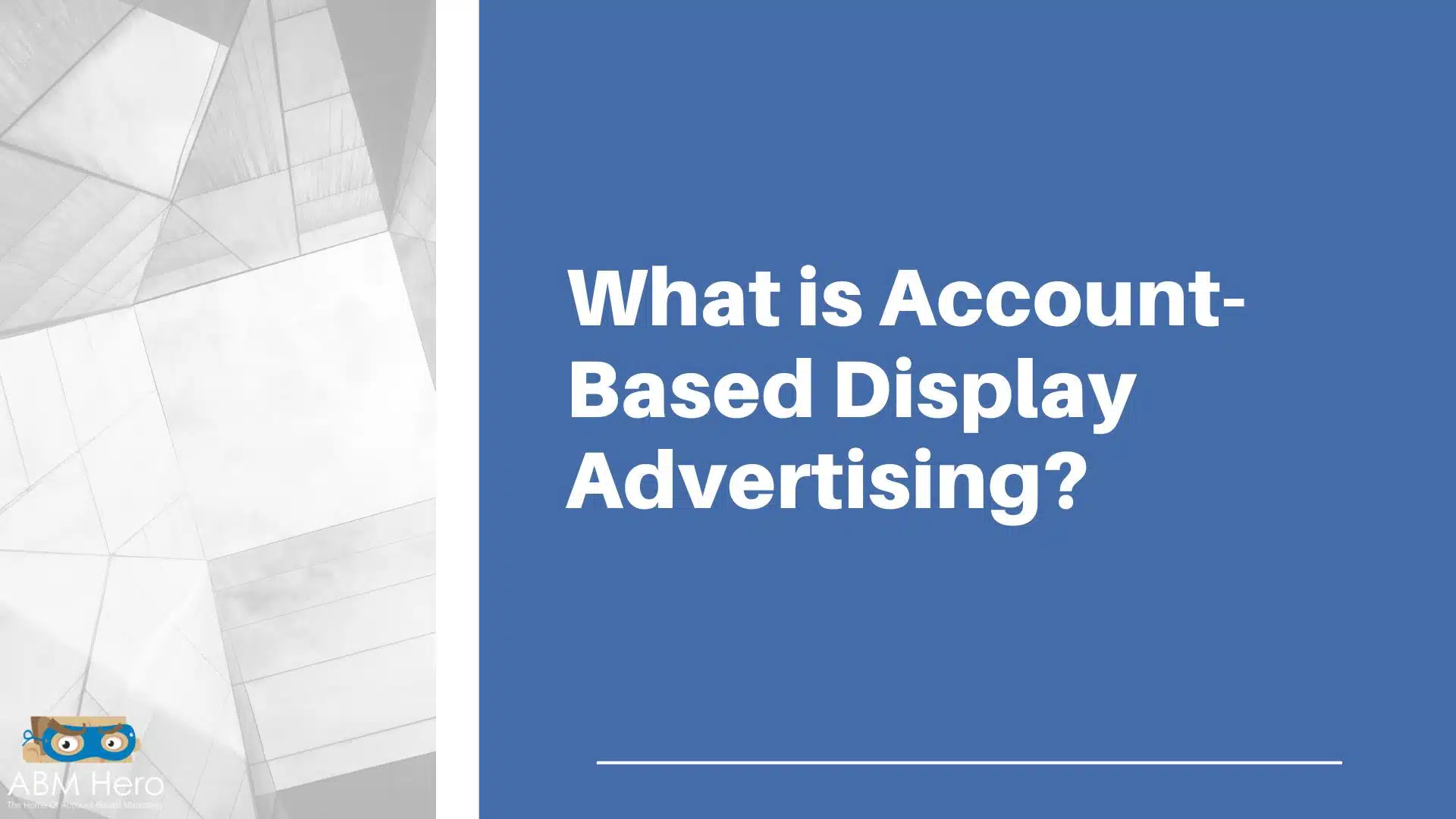Imagine a lively carnival with flashy rides and buzzing crowds. In one quiet corner sits an unassuming booth, easy to miss amid all the excitement.
Just like that modest booth, account-based display advertising in B2B marketing often flies under the radar despite being a powerful tool.
But here’s the secret: it’s time to spotlight this hidden gem.
In this blog, we’re taking you on a journey to uncover why account-based display advertising is your secret weapon for generating leads and boosting ROI.
There is no fancy jargon, just clear insights into the magic of B2B marketing. Let’s go!
What is Account-based Display Advertising?
Account-Based Display Advertising is a precise B2B marketing strategy. It involves strategically showing personalized ads to a carefully chosen group of high-potential accounts.
This approach differs from traditional mass advertising, which tries to reach a broad audience.
Instead of casting a wide net, account-based display advertising engages and converts key accounts that closely match your business’s ideal customer profile (ICP). Let’s illustrate this with an example:
Imagine you run a software company aiming to serve large enterprise clients.
With account-based display advertising, you’d first identify a small group of Fortune 500 companies that are an ideal fit for your ICP.
Instead of running generic ads to a broad audience, you’d create tailored ads and content designed specifically for decision-makers within these chosen companies.
These personalized ads would be displayed on platforms like LinkedIn or industry-specific websites directly in front of the key individuals you want to connect with.
This highly focused approach significantly boosts your chances of grabbing the attention of your ideal clients and forming meaningful relationships with them.
Components of Account-based Display Advertising
Account-based display advertising involves several key components that create a targeted and personalized marketing approach for specific high-value accounts. These components include:
Account Selection – The first step is identifying and selecting the target accounts that align with your ideal customer profile (ICP). This is a crucial step, as the success of your campaign depends on choosing the right accounts to focus your efforts on.
Data and Insights– Accurate and up-to-date data is essential for effective account-based display advertising. You need detailed information about your target accounts, including key decision-makers, industry trends, pain points, and buying behavior. This data helps you craft personalized messages and select the most relevant channels.
Personalized Content– Creating content that speaks directly to the needs and challenges of your target accounts is paramount. This content can include tailored ads, landing pages, email campaigns, and even personalized web experiences.
Multi-Channel Marketing– Account-based display advertising often involves a multi-channel approach. You may use display ads, social media advertising, email marketing, and even direct mail to engage with your target accounts across various touchpoints.
Ad Creative– Crafting compelling ad creatives is essential to capture the attention of your target accounts. These creatives should resonate with the specific pain points and interests of the individuals within your target accounts.
Segmentation and Personalization– Divide your target accounts into segments based on common characteristics or needs. This allows for even more precise targeting and personalization of your ad campaigns.
Cross-Functional Alignment– Effective account-based marketing requires alignment between sales and marketing teams. Both teams must work closely to identify the right accounts, coordinate outreach efforts, and track progress.
Measurement and Analytics– Establish clear key performance indicators (KPIs) to measure the success of your account-based display advertising campaigns. Common KPIs include engagement rates, conversion rates, and the overall return on investment (ROI).
Account Nurturing– Beyond initial engagement, account-based marketing involves ongoing nurturing of target accounts. This may include follow-up emails, additional content, and personalized interactions to move prospects through the sales funnel.
Ad Tech and Tools- Utilize marketing technology and tools to streamline your account-based display advertising efforts. This may include customer relationship management (CRM) systems, marketing automation platforms, ad targeting platforms, and analytics tools.
These components work in tandem to create a holistic account-based display advertising strategy, allowing you to target high-value accounts with precision and build meaningful relationships that drive business growth.
Account-based Display Advertising vs. Account-based Marketing
Account-Based Marketing (ABM) and Account-Based Display Advertising are related concepts but differ in scope and tactics. Here’s a breakdown of their differences:
Account-Based Marketing (ABM):
Strategy Focus– ABM is a comprehensive marketing strategy that targets high-value accounts with a personalized and holistic approach. It involves aligning sales and marketing teams to identify, engage, and nurture specific target accounts.
Account Selection- ABM involves carefully selecting a small number of high-potential target accounts that closely align with your ideal customer profile (ICP).
Tactics– ABM encompasses various marketing tactics beyond just advertising. These tactics include personalized email marketing, content marketing, direct mail, webinars, events, and more.
Personalization– ABM emphasizes creating tailored content and messaging that directly address the unique challenges and needs of the target accounts.
Relationship Building– The primary goal of ABM is to build long-term, meaningful relationships with target accounts, often to secure high-value contracts or partnerships.
Multi-Channel Approach– While advertising can be part of an ABM strategy, it’s just one piece of the puzzle. ABM often involves a multi-channel approach that integrates various touchpoints and marketing activities.
Account-Based Display Advertising
Advertising Focus– Account-Based Display Advertising is a subset of ABM that concentrates explicitly on using display ads to target and engage with key decision-makers within select accounts.
Account Selection– Similar to ABM, account-based display advertising involves selecting a defined list of target accounts that match your ICP.
Tactics- Account-based display advertising primarily revolves around digital channels such as programmatic ads, social media advertising, and content syndication.
Personalization- It emphasizes crafting personalized ad creatives and messages to capture the attention of individuals within the target accounts.
Lead Generation- While relationship building is essential, account-based display advertising often emphasizes generating leads and driving conversions within the selected accounts.
Ad Tech- This approach relies heavily on ad tech tools and platforms for ad targeting, retargeting, and measurement.
In summary, while ABM is a holistic strategy that encompasses a wide range of marketing tactics and focuses on building long-term relationships with a select group of accounts, account-based display advertising is a more specific tactic within ABM that uses digital display ads to engage with key stakeholders within those target accounts.
They can complement each other within an overall ABM strategy, where account-based display advertising is one of the tools in the ABM toolkit.
Common Reasons Account-based Display Advertising is Underrated
The claim that account-based display advertising is often taken for granted by many companies in the modern marketing landscape is rooted in several key reasons:
Complicated Setup
One primary reason is the perceived complexity and resource demands associated with ABM. Implementing ABM, including account-based display advertising, can be time-consuming and resource-intensive. It necessitates the creation of highly targeted content, close collaboration between sales and marketing teams, and investment in specialized tools and technology. Many companies are open to ABM, believing it to be overly intricate and demanding.
Lack of understanding is another hurdle. Some businesses may need to fully grasp the concept and potential benefits of account-based display advertising. This lack of comprehension can lead them to overlook or undervalue the strategy, favoring more familiar and conventional marketing techniques.
Short-Sighted Planning
Moreover, there is often an emphasis on short-term results in the business world. Account-based display advertising, focusing on nurturing relationships with specific accounts, may be perceived as a strategy that takes time to yield results. Companies seeking quick wins may need to pay more attention to its potential for long-term success.
The fear of missing out (FOMO) on the latest marketing trends also plays a role. The marketing landscape is ever-evolving, and some organizations may miss the next big thing if they allocate more resources to account-based display advertising. This fear can divert their attention away from tried-and-true tactics like ABM.
Overemphasis on Lead Generation
Furthermore, there is often a hyperfixation of lead generation in many companies. They prioritize immediate lead generation over developing solid and enduring relationships with high-value accounts. This mindset can lead to undervaluing the importance of account-based display advertising in building lasting connections.
Measuring the success of ABM campaigns can be challenging. ABM involves complex metrics beyond simple lead counts, making it difficult for some companies to gauge the impact of their account-based display advertising efforts accurately. This challenge can sometimes lead to the strategy being perceived as less effective than it truly is.
In light of these factors, it’s essential for businesses to recognize the potential of account-based display advertising within the broader context of ABM and to consider its long-term benefits and impact on building meaningful client relationships.
Despite these difficulties and reasons for neglect, account-based display advertising is still a potent tactic for companies wanting to target high-value accounts to establish long-lasting customer connections. Companies that commit to and engage in ABM frequently discover that it is a highly successful strategy that generates steady revenue and growth.
These tactics work as unshakable cornerstones for companies looking to connect with high-value accounts and succeed in a cutthroat market in a world of marketing distractions and trends.
Remember to consider the power of account-based display advertising and the comprehensive strategy of account-based marketing as you negotiate the always-evolving marketing landscape. They may be the undiscovered gems that propel your company to success.





